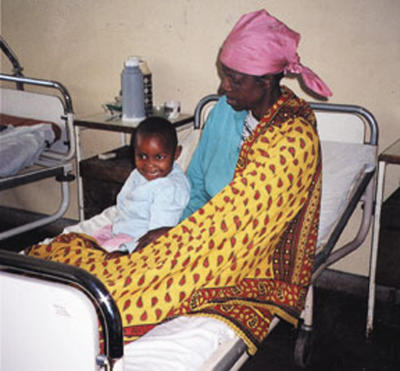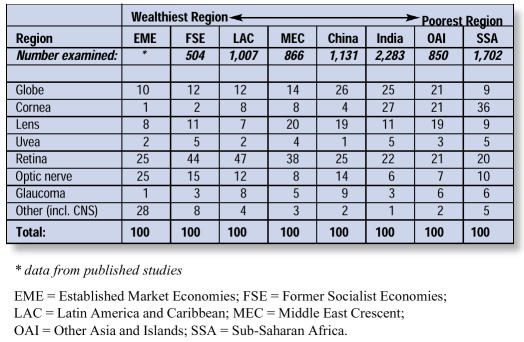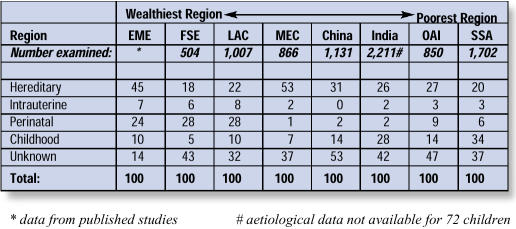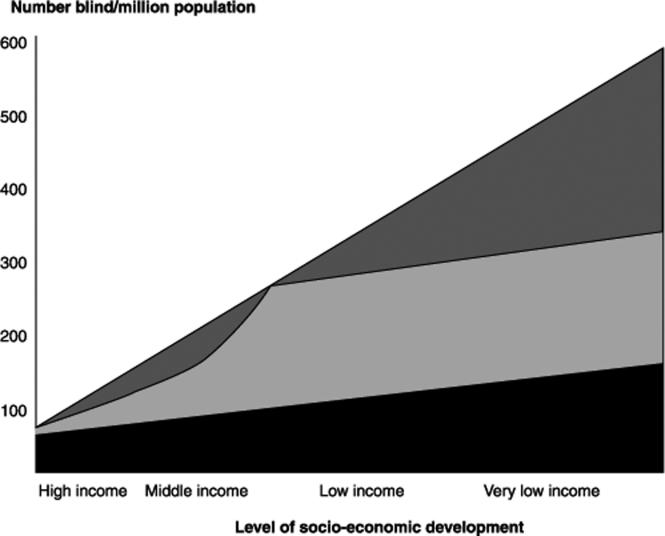The main issues in relation to blindness in children relate to a better understanding of the epidemiology, which has led to improved priority setting. In this article the most recent epidemiological data will be presented, the consequences for the Vision 2020 programme will be discussed, and research priorities considered.
Definitions
A blind child is an individual aged less than 16 years, who has a visual acuity in the better eye of <3/60. However, many studies do not use this definition, which makes it difficult to compare the findings of different studies.
Prevalence and Incidence
The prevalence of blindness in children (i.e., the proportion of the child population who are blind), varies from approximately 0.3/1,000 children in wealthy regions of the world, to 1.2/1,000 in the poorer countries / regions.1 Blindness in children is more common in poor regions for two main reasons: firstly, there are diseases and risk factors which can lead to blindness from causes that do not now occur in industrialised countries (e.g., measles, vitamin A deficiency, ophthalmia neonatorum, malaria), and, secondly, there are fewer well equipped eye departments with ophthalmologists, nurses and ophthalmic paramedics trained in managing treatable causes of blindness (e.g., cataract and glaucoma). The incidence is therefore higher, and fewer blind children have their sight restored.
Incidence data are very difficult to obtain, but it has been estimated that there are 8 new blind children for every 100,000 children each year in industrialised countries. The figures are likely to be higher in developing countries.
Magnitude of Blindness
Globally there are estimated to be 1.4 million children who are blind, and around three quarters live in developing countries. Although the actual number of children who are blind is much smaller than the number of adults blind, e.g., from cataract, the number of years lived with blindness by blind children is almost the same as the total number of ‘blind years’ due to age-related cataract. The high number of blind years resulting from blindness during childhood is one of the reasons why the control of childhood blindness is a priority of the WHO/IAPB Vision 2020: The Right to Sight programme.2
Children's eye care in Tanzania
Photo: Sue Stevens
Causes of Blindness in Children
The available data suggest that there is wide regional variation in the major causes of blindness in children. Tables 1 and 2 show the causes of blindness obtained from examining over 10,000 blind children, with the causes classified using the World Health Organization's classification system.3 These data do not take account of children who are ‘blind’ from refractive errors.
Table 1.
Regional Variation in the Causes of Blindness in Children: Descriptive Classification by World Bank Region (%)
Table 2.
Regional Variation in the Causes of Blindness in Children: Aetiological Categories by World Bank Region (%)
In wealthy parts of the world lesions of the central nervous system predominate, while in poorer countries corneal scarring as a result of acquired diseases are the most important causes. Table 3 shows estimates of the number of blind children by anatomical site, and by underlying cause.
Table 3.
Estimates of Number of Blind Children by Anatomical Site, and Underlying Aetiology
| Anatomical site | Number affected | Examples | Aetiological category | Number affected | Examples |
|---|---|---|---|---|---|
| Retina | 381,000 | Dystrophies | Hereditary | 423,000 | Cataract |
| Cornea | 231,000 | Scarring | Childhood | 260,000 | Measles |
| Whole eye | 230,000 | Microphthalmos | Perinatal | 151,000 | Ophthalmia neonatorum |
| Lens | 170,000 | Cataract | Intrauterine | 50,000 | Rubella |
| Optic nerve | 167,000 | Optic atrophy | Unknown | 516,000 | Phthisis |
| Glaucoma | 68,000 | Glaucoma | |||
| Uvea | 50,000 | Aniridia | |||
| Other | 103,000 | Cortical blindness | |||
| Total: | 1,400,000 | 1,400,000 |
Regional Variation in the Magnitude and Major Causes of Blindness in Children
It is possible to combine what we know about the prevalence of blindness in children with data on causes, and apply this to a total population of one million people (Table 4). This information is perhaps more useful for planning. Figure 1 shows these data.
Table 4.
Estimates of the Magnitude and Major Causes of Blindness in Children per Million Total Population
| High income | Middle income | Low income | Very low income | |||||
|---|---|---|---|---|---|---|---|---|
| CNS = central nervous system | ROP = retinopathy of prematurity | Cat = cataract | ||||||
| % population children | 20% | 30% | 40% | 50% | ||||
| Number of children | 200,000 | 300,000 | 400,000 | 500,000 | ||||
| Blindness prevalence | 0.3/1000 | 0.6/1,000 | 0.9/1,000 | 1.2/1,000 | ||||
| No. of blind children | 60 | 180 | 360 | 600 | ||||
| Cause | % | Cause | % | Cause | % | Cause | % | |
|---|---|---|---|---|---|---|---|---|
| CNS/Other | 80 | CNS/Other | 55 | CNS/Other | 60 | CNS/Other | 35 | |
| ROP | 10 | ROP | 25 | ROP | 0 | ROP | 0 | |
| Cat/glaucoma | 10 | Cat/glaucoma | 20 | Cat/glaucoma | 20 | Cat/glaucoma | 15 | |
| Scarring | 0 | Scarring | 0 | Scarring | 20 | Scarring | 50 |
Fig. 1.
Pattern of Blindness in Children by Level of Socio-Economic Development
Avoidable Causes
In all regions of the world there are causes which are amenable to primary, secondary and tertiary prevention, but the proportions vary from region to region (Table 5).
Table 5.
Regional Variation in Avoidable Causes of Blindness
| High income Blind = 90,000 | Middle income Blind = 290,000 | Low income Blind = 1,020,000 | |||
|---|---|---|---|---|---|
| ∗ due to infections, trauma and tumours | |||||
| ROP | 9,000 (10%) | Cataract | 45,000 (15%) | Corneal scar | 200,000 (20%) |
| Teratogens | 5,400 (6%) | ROP | 29,000 (10%) | Cataract | 133,000 (13%) |
| Cataract | 5,400 (6%) | Glaucoma | 17,000 (6%) | Glaucoma | 60,000 (6%) |
| Glaucoma | 2,000 (2%) | Teratogens | 12,000 (4%) | Optic atrophy∗ | 60,000 (6%) |
| Total avoidable: | 21,800 (24%) | Total avoidable: | 103,000 (35%) | Total avoidable: | 453,000 (45%) |
Vision 2020 Priorities
Given these findings, the following conditions are priorities for control:4
Corneal scarring, due to measles, vitamin A deficiency, harmful traditional eye medicines, and ophthalmia neonatorum: priorities in poor and very poor regions
Cataract and glaucoma: important treatable causes in all regions
Retinopathy of prematurity, a condition which is preventable and treatable; important in middle income countries, and in urban centres in developing countries
Refractive errors: treatable cause in all regions
Low vision: services need to be expanded or developed in all regions.
Targets for disease control
The following targets have been agreed for disease control:
Reduce the global prevalence of childhood blindness from 0.75/1,000 children to 0.4/1,000 children.
Elimination of corneal scarring caused by vitamin A deficiency, measles, or ophthalmia neonatorum.
Elimination of new cases of congenital rubella syndrome.
All children with congenital cataract to receive appropriate surgery, with immediate and effective optical correction, in suitably equipped specialist centres.
All babies at risk of retinopathy of prematurity to have fundus examination, by a trained observer, 6–7 weeks after birth. Cryotherapy or laser treatment to be provided for all those with treatable disease.
All school children to receive a simple vision screening examination, with glasses provided for all those with significant refractive error. This should be integrated into the school health programme.
Human resource development
The implications and recommendations for human resources development are as follows:
Ensure that prevention of childhood blindness is an explicit aim of all primary health care programmes.
Ensure that all secondary level eye clinics have facilities to provide appropriate spectacles for children with refractive errors.
Train one refractionist per 100,000 population by 2010.
Train at least one low vision worker for every 20 million children, by 2010, and for every 5 million by 2020.
Train one paediatric-orientated ophthalmologist for every 50 million population by 2010, and one per 10 million population by 2020.
Appropriate technology & infrastructure
There is the following need for appropriate technology and infrastructure development:
Development of low cost, high quality low vision devices, which should be widely available, even in low income countries.
Establish a network of specialist ‘childhood blindness’ tertiary centres.
In this edition of the Journal of Community Eye Health there are articles which address some of the priority causes of blindness in children. The article on cataract discusses the relative merits of intraocular lens implantation in children, as a means of correcting their aphakia. The article on retinopathy of prematurity from Brazil highlights how screening programmes need to be expanded in Latin America if blindness from ROP is to be brought under control.
Research Issues
Corneal scarring. The control of diseases that cause corneal scarring lies in primary health care, public health interventions, and child survival programmes. However, there is still a need to develop cost effective, sustainable interventions at the community and household level for the control of vitamin A deficiency, interventions that do not depend on vitamin A supplementation.
Cataract. Cataract surgery is much more difficult in children, and very few clinical trials have been undertaken to explore the optimum management. Further research is also needed into the aetiology of cataract in different parts of the world, as well as qualitative research to investigate barriers to the uptake of cataract surgery.
Retinopathy of prematurity. The pattern of disease in middle income countries seems to be different from that currently seen in industrialised countries. There is a need for research into risk factors in different settings, and the validity of different methods of screening for threshold disease needs to be investigated.
Low vision. There are very few studies of low vision in children. It is not really known how common it is, and what the major causes are at the population level. There are virtually no studies which have addressed the issue of best low vision devices for children.
Diseases of unknown cause. There are many blinding eye diseases where the underlying cause is not known, e.g., congenital anomalies of the eye. Research is needed to try and clarify the relative contribution of genetic and environmental risk factors.
References
- 1.Gilbert C E, Foster A. Childhood blindness in the context of VISION 2020 – The Right to Sight. Bull WHO. 2001;79:227–232. [PMC free article] [PubMed] [Google Scholar]
- 2.World Health Organization, Geneva. Global Initiative for the Elimination of Avoidable Blindness. Geneva WHO/PBL/97.61.
- 3.Gilbert C, Foster A, Negrel D, Thylefors B. Childhood blindness: a new form for recording causes of visual loss in children. Bull WHO. 1993;71:485–489. [PMC free article] [PubMed] [Google Scholar]
- 4.World Health Organization, Geneva. Preventing blindness in children: Report of WHO/IAPB scientific meeting. (Unpublished document WHO/PBL/00.77)






